Falafel Plate (with Hummus, Tahini Sauce and Labneh)
A falafel plate is a great way to turn crispy Middle Eastern falafel into an easy dinner. Use this mezze-style falafel platter recipe as a guide. And swap and change ingredients and portions to your heart’s content.
The mix of golden brown falafel balls, creamy hummus, lemony tahini sauce and fresh veggies is a classic Middle Eastern meal.
Serve your falafel mezze platter on a large serving plate as a grazing board for a crowd. Or create individual falafel plates for dinner.
You can make homemade falafel, hummus, tahini sauce and labneh balls – I outline a great get-ahead strategy for all the homemade mezze plate goodies. But you can make this easy falafel plate even simpler by opting for shop-bought versions.
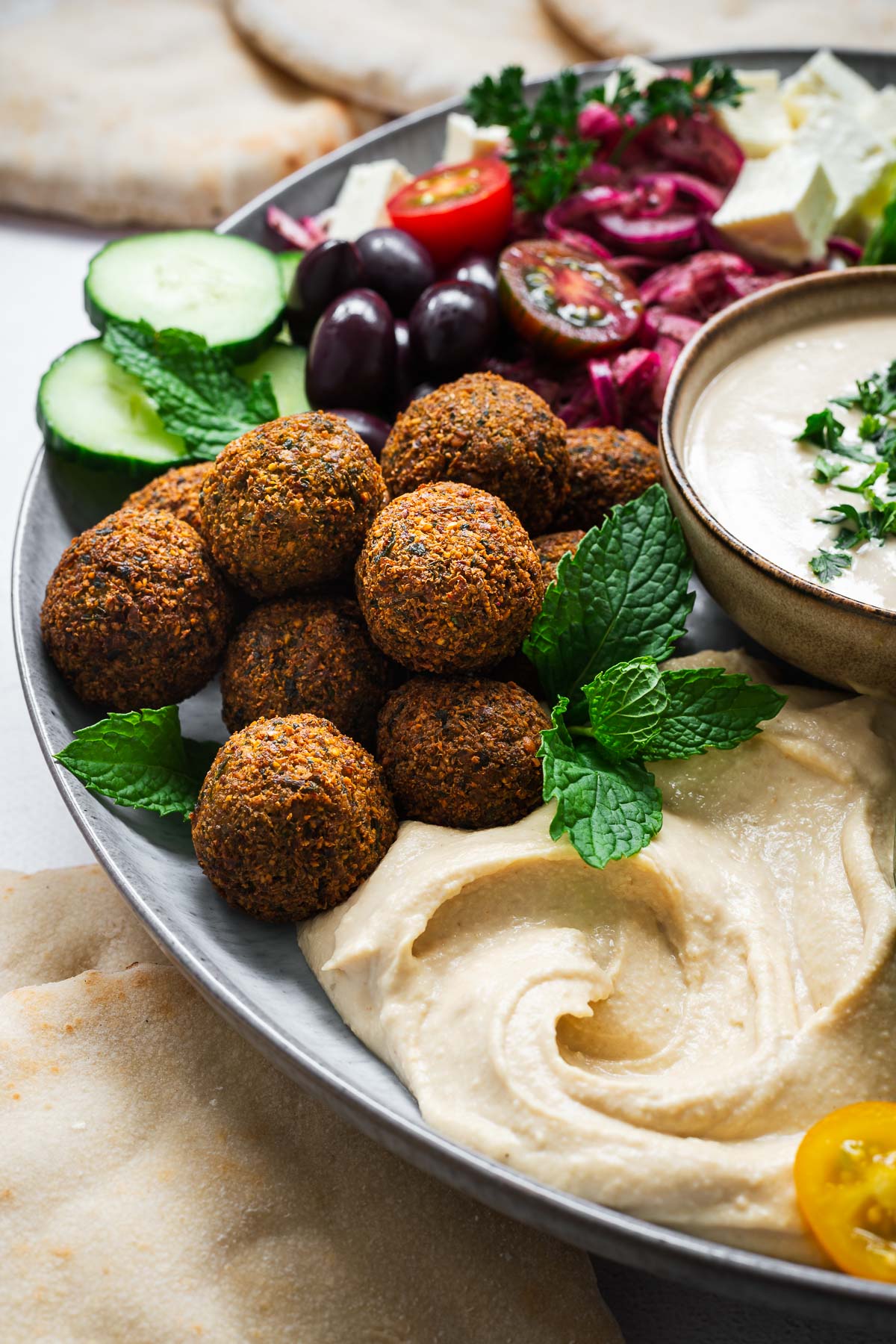
Keep reading to learn all the tips and tricks of assembling a falafel plate or jump ahead.
In this post:
- Falafel plate ingredients
- How to make a falafel plate (and how to get ahead with prep)
- More falafel serving suggestions
- Falafel plate recipe card
What is a falafel plate?
A falafel plate is a dish of falafel patties or small balls (herbed chickpea fritters) with accompaniments such as hummus, tahini sauce, vegetables (like tomato, cucumber, and lettuce), pita bread, and pickles. It is a popular vegetarian dish in Middle Eastern cuisine.
You can follow the falafel plate recipe and arrange the falafel and accompaniments on a large serving platter. Or make smaller individual falafel plates.
Falafel plate ingredients
This falafel plate includes classic Middle Eastern components like delicious falafel balls, creamy hummus, lemon tahini sauce, fresh vegetables and pita bread. I also add labneh balls and sumac onions.
Use the falafel plate recipe as a template and make it your own. Try these classic falafel plate ingredients or spice things up.
Falafel mezze platters are perfect for getting creative in the kitchen!
Falafel
Whether you opt for homemade Middle Eastern falafel, baked falafel (with canned chickpeas) or shop-bought falafel, they are the star of this mezze platter. I use four small falafel per person with a generous side of Middle Eastern dips, spreads and fresh vegetables.
Making falafel for the first time can be intimidating, but there is no need to worry! Homemade falafel are easy once you get the hang of it.
For traditional falafel, you should start a day ahead by soaking dry chickpeas in water overnight. Never make traditional falafel from canned chickpeas, they don’t have the starch required to bind the falafel mixture, and they WILL fall apart in the hot oil.
Use a food processor to grind the dried chickpeas (soaked in water overnight) with onion, garlic cloves, lots of fresh green herbs, spices and baking powder. Then shape your falafel mixture into small balls or patties.
You can refrigerate the falafel mixture for 24 hours. Or freeze the shaped falafel balls for a month and cook them straight from frozen.
The Middle Eastern falafel recipe has all the falafel tips and tricks you need for delicious falafel with a crispy exterior with a soft and fluffy flavourful inside. Or try this quick and easy baked falafel recipe.
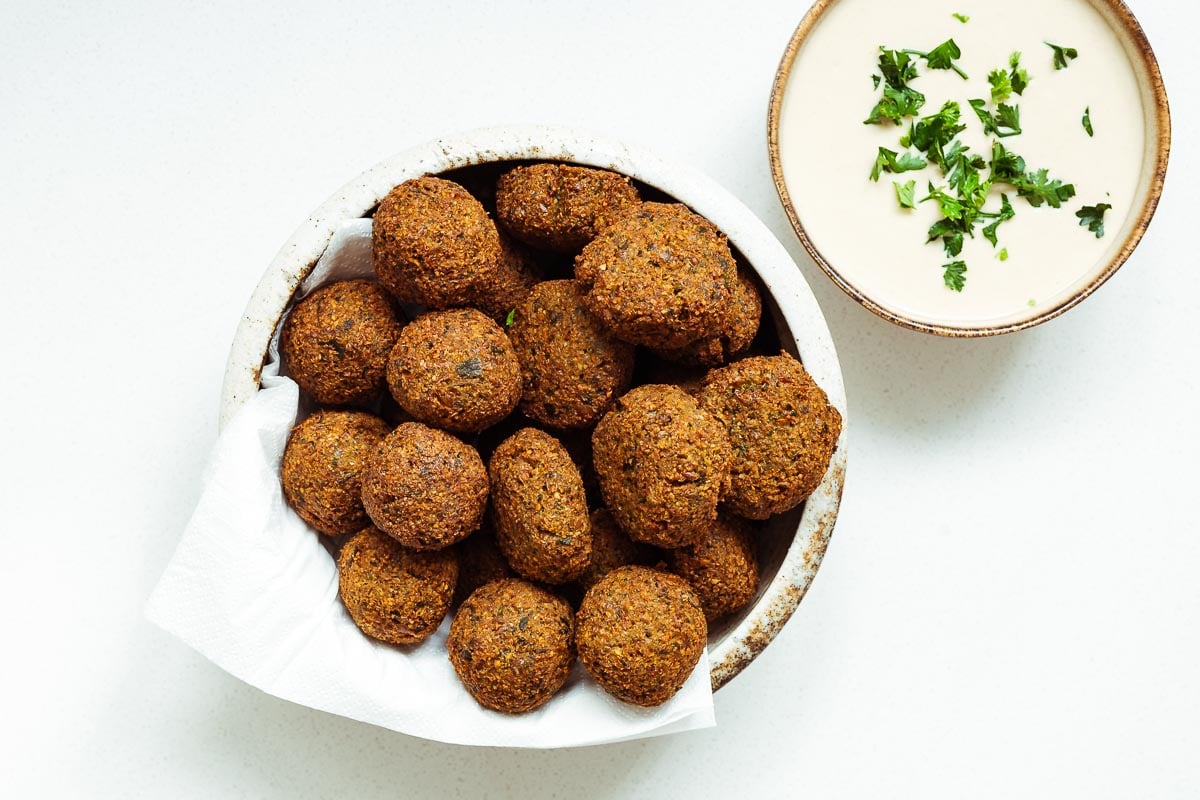
Falafel sauce
Every falafel plate needs falafel sauce. It’s a key ingredient in a Middle Eastern falafel plate. You can use tzatziki sauce, but I prefer to serve falafel with tahini sauce.
Tahini sauce adds a rich, nutty flavour that complements the herbs and spices in the delicious falafel. It is the preferred sauce for traditional Israeli falafel plates.
Tahini is made from ground sesame seeds and is ubiquitous in Middle Eastern dishes. You can make tahini from toasted sesame seeds with a food processor or high-speed blender. Or buy good quality tahini from Levantine countries (like Israel).
Try this plant-based tahini sauce recipe. You can make it up to three days ahead. Refrigerate it in an airtight container until ready to use.
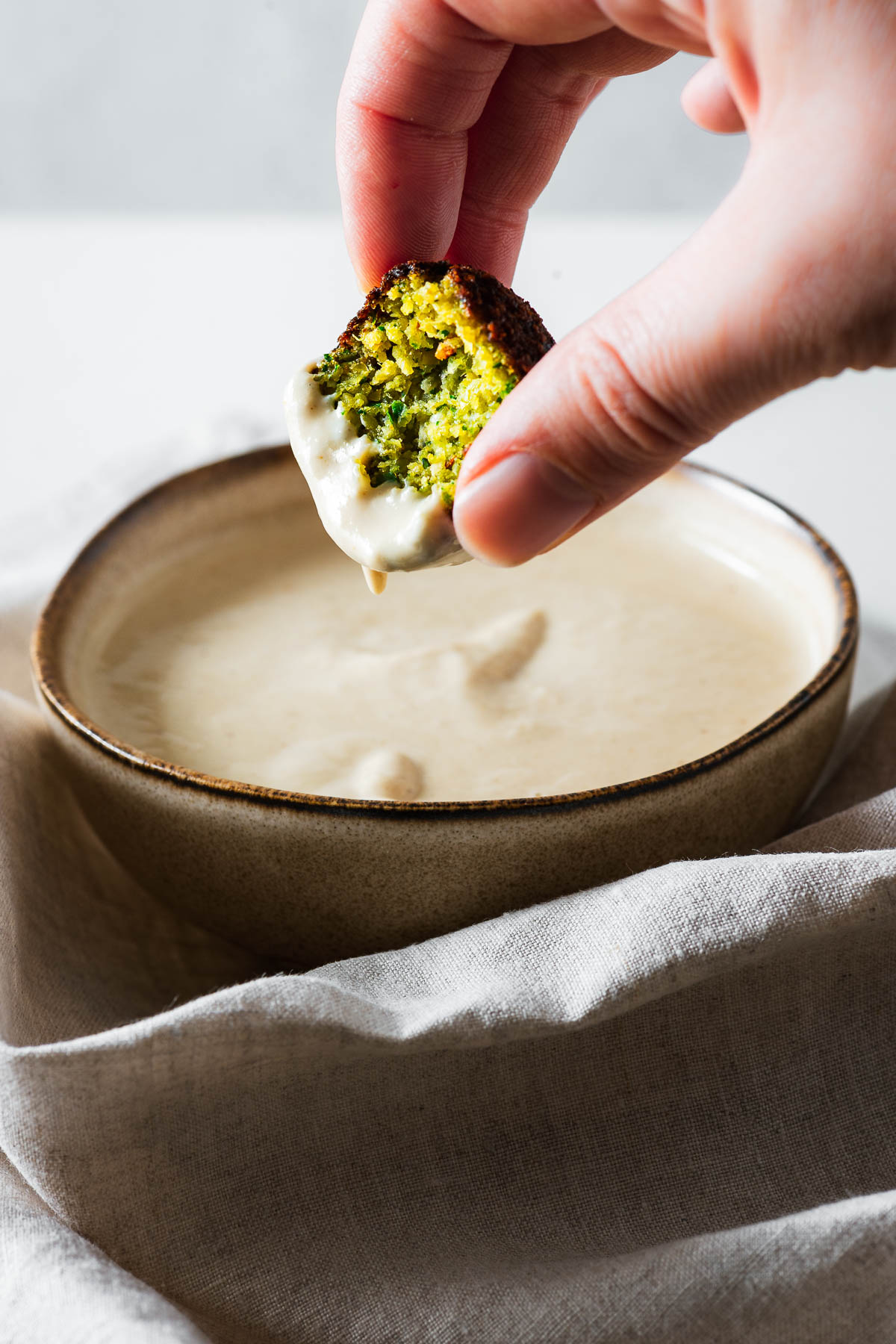
Hummus
Hummus is an essential part of the falafel plate. The creamy chickpea dip is the perfect accompaniment to the crispy falafel balls.
Find good quality store-bought hummus.
Or try this lemon hummus recipe. The recipe has in-depth instructions for the creamiest homemade hummus using dried or canned chickpeas. This flavour-packed harissa hummus recipe uses canned chickpeas.
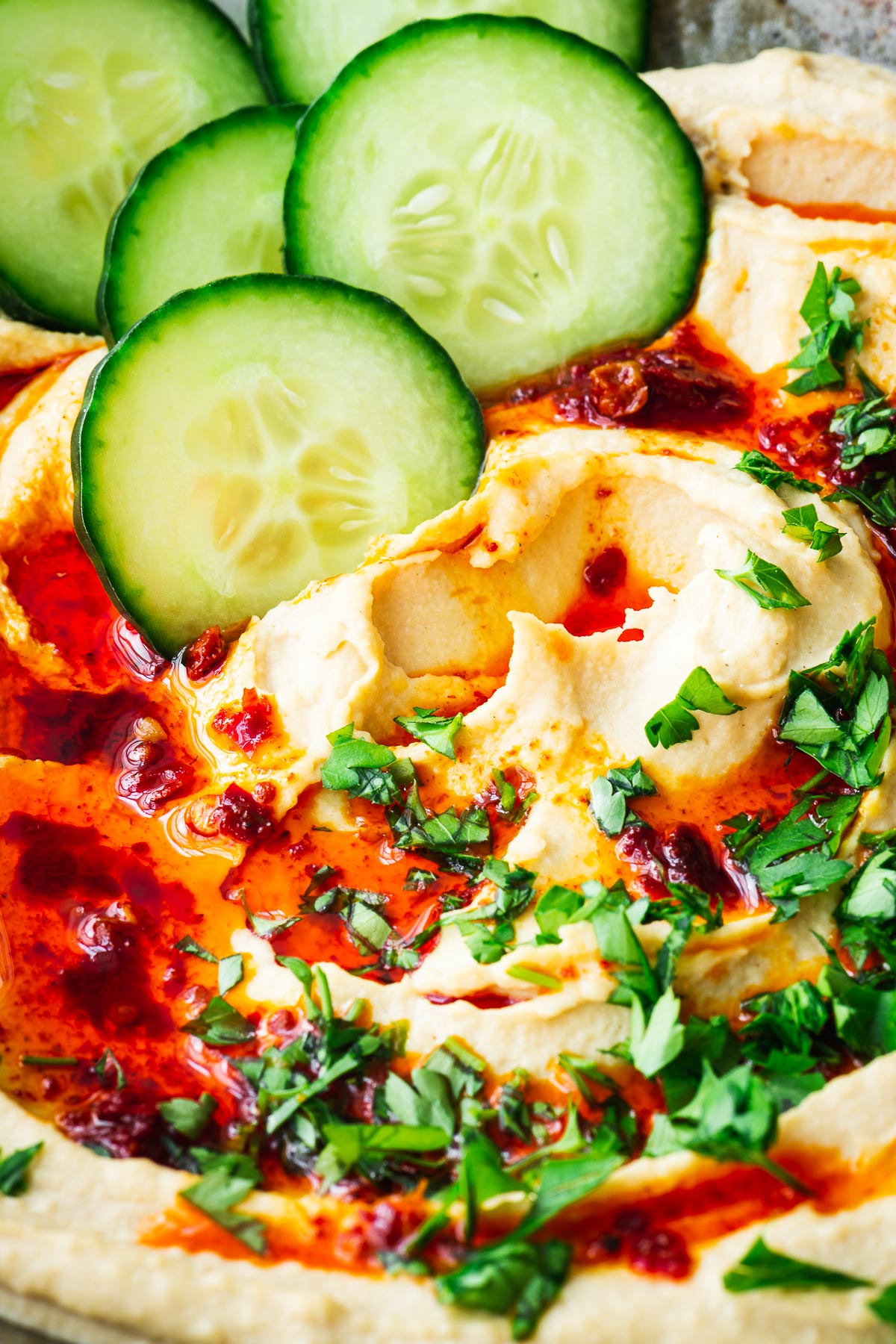
Sumac onions
Sumac onions are tart and slightly sweet. It’s not as pungent as raw onion. And it’s super easy to make – see the recipe card for ingredients and instructions.
But if you’re in no mood to make sumac onion salad, serve thinly sliced raw onions instead. Or use shop-bought pickled red onions.
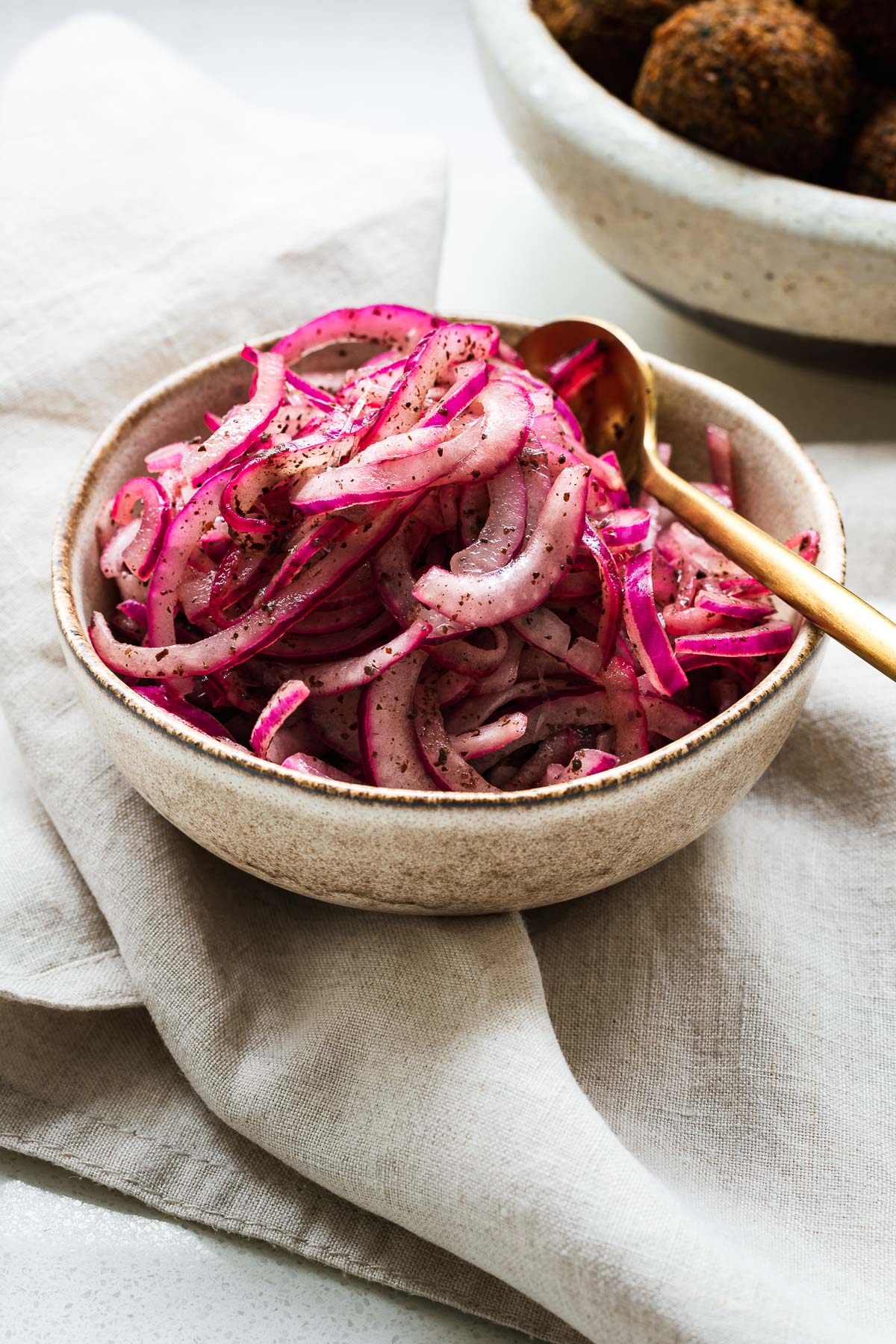
Labneh balls
Labneh is a strained yoghurt condiment common in Middle Eastern and Mediterranean cuisines. It is a tangy, creamy yoghurt cheese – perfect for dips and spreads.
I adore the tangy flavour and creamy texture of the strained yoghurt. And za’atar coated labneh balls make perfect individual portions, ready to be stuffed into a pita pocket.
But you can also serve labneh as a spread, drizzled with olive oil and sprinkled with za’atar. Or use thick greek yoghurt instead (if you don’t already have tzatziki on the falafel plate).
Learn how to make labneh at home (it’s super easy) and create your own labneh balls in olive oil. You can make the labneh balls weeks ahead. Or opt for store-bought labneh balls.
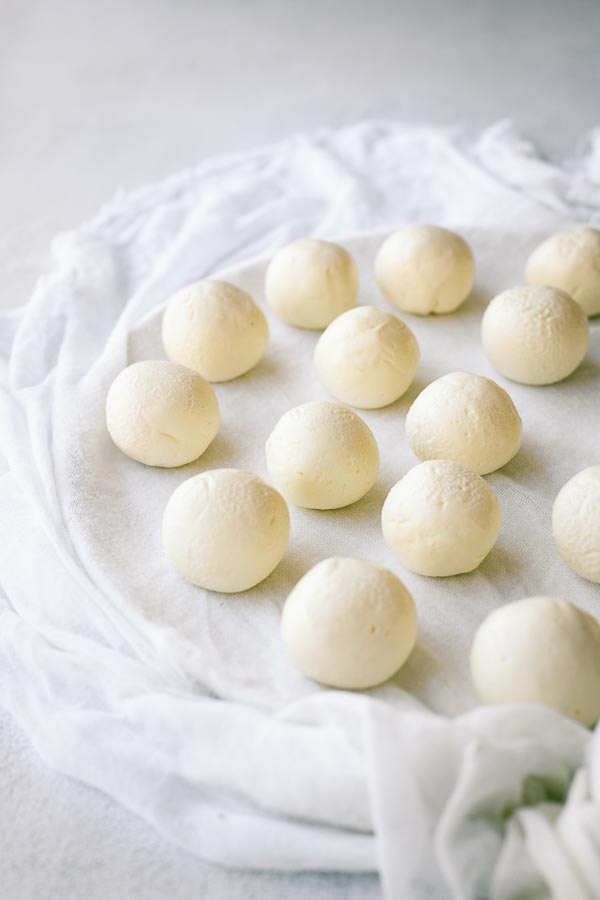
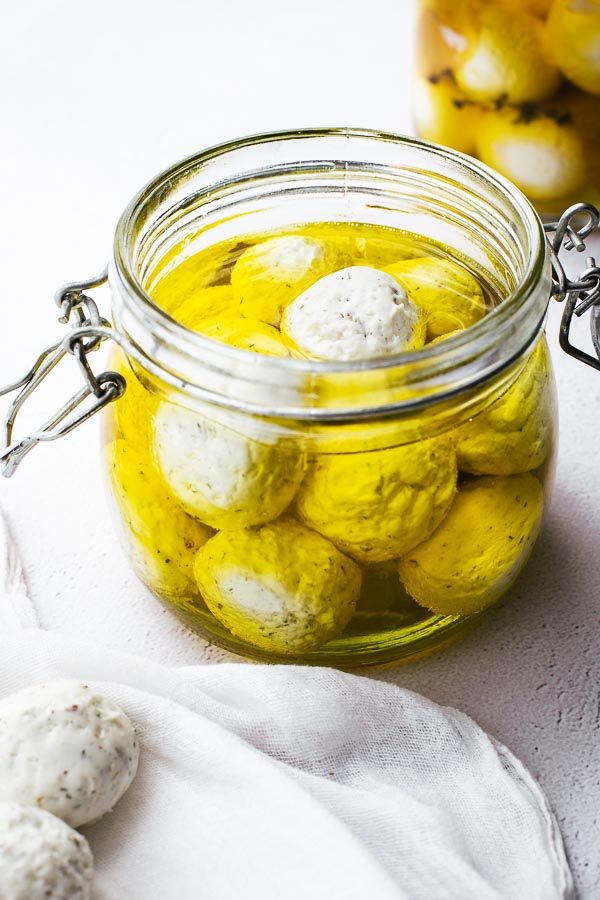
Fresh veggies
I use small heirloom tomatoes, cucumber slices, kalamata olives and cubed feta cheese. Essentially, a deconstructed greek salad.
You can also use cucumber salad, cherry or grape tomatoes, sliced red pepper, or mix it up with green olives.
Or serve it as a mezze salad platter with an Arabic chopped salad, Israeli-style tahini salad, or bulgur wheat salad.
To serve
A few fresh herb sprigs add instant freshness and colour to the falafel plate. Try a few whole mint sprigs. Or sprinkle the platter with finely chopped parsley or cilantro.
Serve the mezze platter with pita bread – use whole-wheat pitas for a wholesome meal. You can also use pita wedges or pita chips. Or omit the bread to turn this falafel plate into a falafel salad.
Finally, I love to add a bit of hot sauce. My favourite hot sauce for falafel is zhoug. The vibrant green mix of cilantro, green chillies and spices are slightly spicy and super flavourful. Or use your favourite shop-bought hot sauce.
Keeping it plant-based?
For a vegan mezze platter, use vegan feta and skip the labneh balls. Falafel are plant-based, and so are the remaining ingredients.
Add creamy vegan baba ganoush instead of the labneh. Try this epic baba ganoush recipe (via cookie and kate).
A falafel plate can be a super easy vegan dinner. Leave the pita bread if you need it to be gluten-free too. And serve it with a grain salad, like this bulgur wheat salad, instead.
Want to add more?
This simple falafel plate is very flexible, swap and change ingredients as you please.
A falafel plate works well with any Middle Eastern side dishes, dips or sauces:
- muhammara (Lebanese walnut and red pepper dip)
- tabbouleh or bulgur wheat salad
- pickled vegetables
- roasted vegetables (like eggplants or red bell peppers)
- salad leaves (like crunchy iceberg or spicy rocket)
Or see this list post for more side dishes and sauces to serve with falafel.
How to make a mezze-style falafel platter
Whether you serve the mezze-style falafel platter as a grazing board for a crowd or a falafel plate for one, you can get ahead by prepping some ingredients weeks in advance.
You can, of course, use shop-bought falafel, labneh, hummus, tahini sauce and zhoug.
But, if homemade, these ingredients can be prepped well in advance. This means you can whip up an easy mezze plate with delicious homemade falafel in no time.
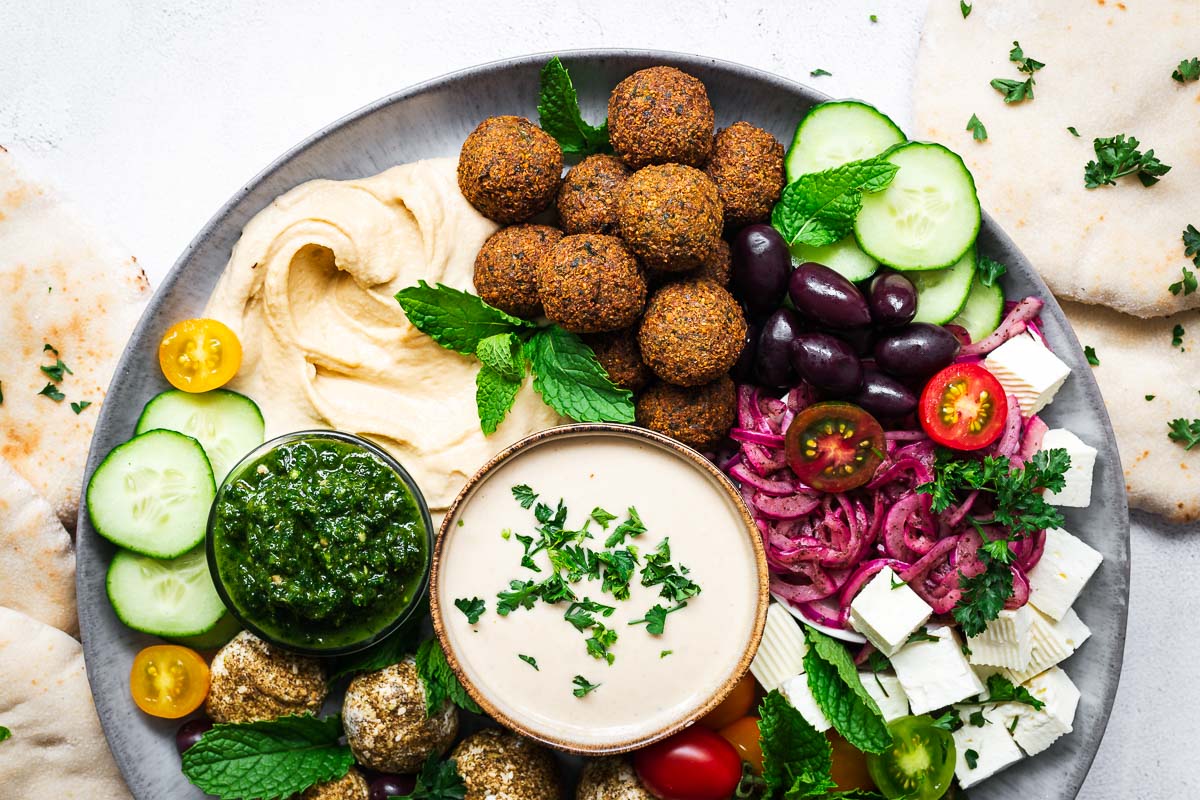
A few weeks ahead
You can make labneh from strained yoghurt and preserve labneh balls in olive oil for up to four weeks. This is a great way to get ahead. Then roll the labneh balls in za’atar before serving. Or try garlic and herb labneh balls.
Zhoug sauce can last in the fridge for three weeks. So get ahead by making your zhoug a week or so before.
You can freeze uncooked falafel balls and fry them straight from frozen. Make the falafel mix up to four weeks in advance.
A few days ahead
Make your homemade hummus and lemon tahini sauce. Both will keep a few days refrigerated in an airtight container. And the lemon tahini sauce will only get more delicious as the garlic mellows in the lemony tahini.
A day before
If you did not freeze the falafel balls, you can make your traditional falafel mixture one day before. The mix of ground chickpeas, onion, garlic, herbs, and baking powder can remain in the fridge for 24 hours before cooking.
Assemble the falafel plate
When you are ready to serve your mezze plates, cook the falafel in batches and drain it on a plate lined with paper towel.
Arrange all of the ingredients on a large platter or individual plates.
You can also serve falafel at room temperature, but they are honestly so good when they are still warm and crispy.
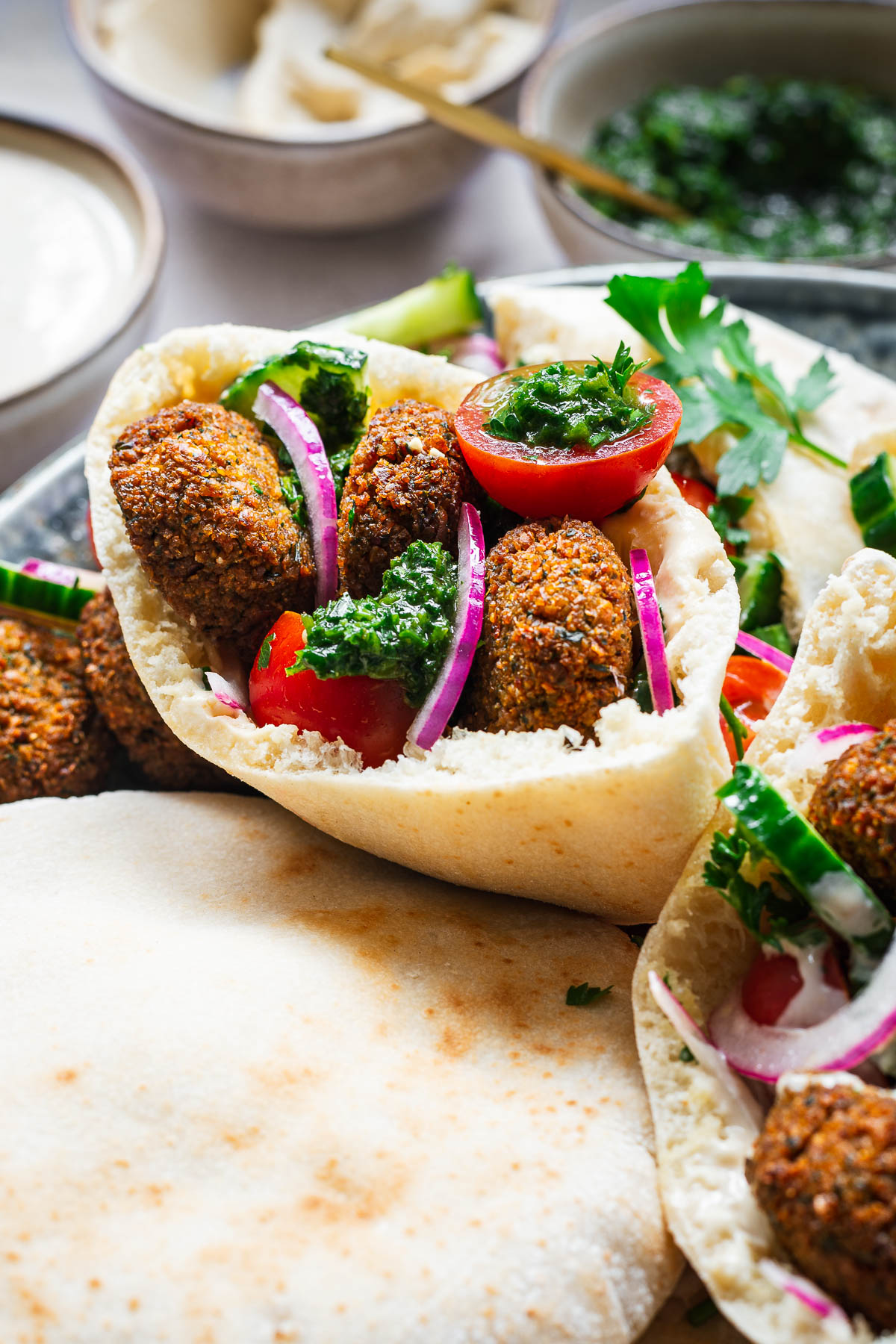
Frequently asked questions
Cut your pita in half to create two pita pockets. Spread it with hummus and stuff it with falafel and fresh vegetables like tomatoes, cucumbers and onions. Then top the pita sandwich with tahini sauce, hot sauce and finely chopped parsley.
Falafel are typically served in pita bread with hummus, tahini sauce (tahini paste, lemon juice, garlic, and water), fresh vegetables (like tomato and cucumber), and sometimes pickled vegetables. Or the same ingredients can be arranged on a falafel plate.
Want more ideas to serve falafel?
Falafel are best when freshly fried and still warm. But you can also let them cool to room temperature for an easy picnic meal. Fresh falafel always beat pre-cooked and chilled falafel from any local grocery store.
Serve your falafel as:
- a snack with dips and tzatziki or tahini sauce,
- a falafel sandwich stuffed into a warm pita pocket with creamy hummus, chopped tomatoes and cucumber, fresh parsley, a squeeze of lemon juice and a generous drizzle of tahini sauce,
- a vegan falafel burger with a large falafel patty stuffed into a hamburger roll with relish, crunchy lettuce and pickles,
- a falafel plate or mezze spread alongside more Middle Eastern sides like lemon hummus, labneh balls and sumac onions,
- a vegan falafel bowl with bulgur wheat salad and tahini dressing, or
- a falafel salad with a zesty Arabic chopped salad, an Israeli-style tahini salad or a fresh green salad, topped with crispy falafel.
See this list for the best sides and sauces to serve with falafel.
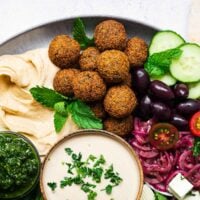
Ingredients
- 16 falafel balls*
- 1 cup tahini sauce
- 1 cup hummus
Sumac onions
- 1 red onion, thinly sliced in half-moons
- 1 tablespoon sumac
- 1 tablespoon freshly squeezed lemon juice
- a pinch of ground salt
Za’atar labneh balls
- 8 plain labneh balls*
- 2 tablespoon za’atar
To serve
- 1 cup cubed feta cheese
- 1 cup mixed small tomatoes, or cherry tomatoes
- ½ English cucumber, sliced into rounds
- ½ cup olives, green or black
- extra-virgin olive oil
- salt flakes and black pepper
- a few sprigs of mint and parsley, as garnish
- zhoug, or hot sauce
- 4 pita bread*, or small flatbreads
Instructions
- If you’re making them from scratch, make the falafel, tahini sauce and lemon hummus. You can do this a day ahead.
Sumac onions
- Finely slice onions and leave them to soak in cold water for at least 10 minutes (up to 30 minutes) while you prepare your vegetables.
- Thoroughly drain the onions, then mix them with sumac, lemon juice and a pinch of salt. Use your fingers to massage the sumac into the onions. Set aside for another 20 minutes.
Za’atar labneh balls
- Place the za’atar on a small plate and roll each labneh ball in the za’atar to coat.
Assemble the falafel plate
- Use a large serving plate, wooden board or individual serving plates.
- Put the falafel dipping sauce (tahini sauce or tzatziki) in a small bowl and place it in the centre of the serving plate.
- Swirl the hummus directly on the plate, or use another small bowl if you’re using a wooden serving board.
- Arrange the falafel, sumac onions, labneh balls, feta cubes, tomatoes, cucumber and olives snuggly around the falafel sauce.
- Drizzle the veggies with olive oil and sprinkle with salt and pepper.
- Garnish the falafel plate with a few sprigs of fresh herbs.
- Serve with pita bread and zhoug (or hot sauce) on the side.
Notes
- I use 16 small falafel balls (less than an ounce / about 25 grams each) from this Middle Eastern falafel recipe when I make a falafel plate for four. If you plan to make your own traditional falafel, you should start a day ahead and place dried chickpeas in water to soak overnight. Or you can make quick and easy baked falafel using canned chickpeas. And, of course, you can also use store-bought falafel.
- Buy ready-made labneh balls. Or, roll fresh labneh into balls (about a heaped tablespoon each) with lightly oiled hands. Place the balls in the fridge to set for at least 2 hours before coating them with the za’atar. See how to make labneh balls.
- I always buy olives with the pip. Either use an olive pitter to remove the pips or warn diners that the olives still have pips.
- Skip the pita bread if you want to make it a gluten-free falafel salad platter.
- You can build individual plates if you don’t have a large enough serving board.
- The prep time in the recipe card does not include making homemade falafel mixture, hummus, tahini sauce and labneh.
Related falafel plate recipes:
- Lemony Hummus Without Garlic (3 Ways)
- Easy Lemon Tahini Sauce
- Crispy Middle Eastern Falafel
- Easy Baked Falafel (With Canned Chickpeas)
- Sumac Onions (Marinated Red Onion Salad)
- How to Make Labneh (Yoghurt Cheese)
- Garlic and Herb Labneh Balls in Olive Oil
- Zhoug Sauce (Spicy Cilantro Skhug)
- What to Serve With Falafel (the Best Sides & Sauces)
